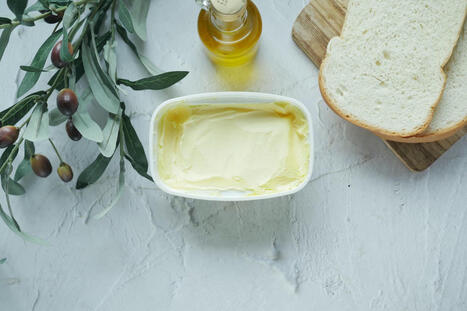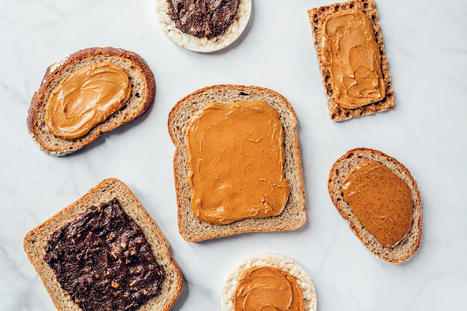Can knowing the difference between butter and margarine help Individuals looking to improve cholesterol levels?
Butter and Margarine
Individuals watching their cholesterol levels and switching from butter to margarine may have heard that it may be worse for heart health. What research has to say about the healthiest spread and the butter and margarine debate?
History
When margarine was developed as a substitute for butter, it was shown to be associated with an increased risk of heart disease because of its saturated fat content. Margarine is made from plant-based oils like canola, palm fruit, and soybeans. Nutritionists and researchers saw it as a healthier alternative. It is lower in saturated fat and has no cholesterol but contains high levels of trans fats, which raise unhealthy LDL cholesterol levels and lower healthy HDL cholesterol levels. (Ginter, E., and Simko, V. 2016)
Margarine Trans Fat and Butter Saturated Fat
Most of margarine's unsaturated fats undergo hydrogenation, creating harmful trans fats. Trans fat raises unhealthy LDL cholesterol levels more than saturated fat. The trans-fatty acids solidify and maintain margarine consistency at room temperature. Stick margarines, the hardest type, contain the most trans fats and are still sold despite what is known about the damage they can do. (Brouwer, I. A. et al., 2010) Clinical studies showed these trans fats are associated with a 28% increased risk of death from heart disease and a 34% increased risk of death. (de Souza, R. J. et al., 2015)
Margarine Types
Some softer and liquid margarine products contain less trans fat than stick versions. They are low in saturated fat and high in unsaturated fat. Individuals can determine how much trans fat the margarine has by its softness. Those that are more solid at room temperature contain more trans fats than those in a tub, which are softer. However, some soft options can contain trans fats. If the label has partially hydrogenated oil, it's recommended to avoid it. (Garsetti, M. et al., 2016) Some newer margarines are enriched with plant sterols, which block cholesterol absorption and help lower LDL levels. These are healthy choices if trying to lower LDL. (Ras, R. T. et al., 2014)
Butter
Butter is primarily made up of saturated fat and cholesterol and comes in a stick and spread. One tablespoon of butter contains around 30 milligrams of cholesterol and 7 grams of saturated fat. The maximum amount allowed daily is 200 milligrams and 10 milligrams, respectively. Both types of fat are linked to rising cholesterol levels and the risk of heart disease. Butter from grass-fed cows is higher in omega-3 fatty acids, essential for heart health, making it far more nutritional than the more widely used butter from conventionally-fed cows. (Hebeisen, D. F. et al., 1993)
Other Options
Butter or margarine are not the healthiest options. Olive, avocado, and other vegetable-based spreads are the most heart-healthy options. (Yubero-Serrano, E. M. et al., 2019) Use avocado oil as a cooking oil when sautéing or roasting vegetables. Consider substituting applesauce, nut butters, or squash purees in baked goods. Look for soft versions of margarine as a bread spread that contain plant sterols and no hydrogenated oils.
Injury Medical Chiropractic and Functional Medicine Clinic uses an integrated approach to create personalized care plans for each patient to restore health and function to the body through Nutrition and Wellness, Functional Medicine, Acupuncture, Electro-Acupuncture, and Sports Medicine protocols. If the individual needs other treatment, they will be referred to a clinic or physician best suited for them. Dr. Jimenez has teamed up with top surgeons, clinical specialists, medical researchers, nutritionists, and health coaches to provide the most effective clinical treatments.
Enhancing Health Together: Multidisciplinary Evaluation and Treatment
The information herein is not intended to replace a one-on-one relationship with a qualified healthcare professional or licensed physician and is not medical advice. We encourage you to make healthcare decisions based on your research and partnership with a qualified healthcare professional. Our information scope is limited to chiropractic, musculoskeletal, physical medicines, wellness, sensitive health issues, functional medicine articles, topics, and discussions. We provide and present clinical collaboration with specialists from various disciplines. Each specialist is governed by their professional scope of practice and their jurisdiction of licensure. We use functional health & wellness protocols to treat and support care for the injuries or disorders of the musculoskeletal system. Our videos, posts, topics, subjects, and insights cover clinical matters, issues, and topics that relate to and directly or indirectly support our clinical scope of practice.* Our office has reasonably attempted to provide supportive citations and identified the relevant research studies or studies supporting our posts. We provide copies of supporting research studies available to regulatory boards and the public upon request.
We understand that we cover matters that require an additional explanation of how it may assist in a particular care plan or treatment protocol; therefore, to further discuss the subject matter above, please get in touch with Dr. Alex Jimenez or contact us at 915-850-0900.
Dr. Alex Jimenez DC, MSACP, CCST, IFMCP*, CIFM*, ATN*
email: coach@elpasofunctionalmedicine.com
Licensed in: Texas & New Mexico*
References
Ginter, E., & Simko, V. (2016). New data on harmful effects of trans-fatty acids. Bratislavske lekarske listy, 117(5), 251–253. https://doi.org/10.4149/bll_2016_048
Brouwer, I. A., Wanders, A. J., & Katan, M. B. (2010). Effect of animal and industrial trans fatty acids on HDL and LDL cholesterol levels in humans--a quantitative review. PloS one, 5(3), e9434. https://doi.org/10.1371/journal.pone.0009434
de Souza, R. J., Mente, A., Maroleanu, A., Cozma, A. I., Ha, V., Kishibe, T., Uleryk, E., Budylowski, P., Schünemann, H., Beyene, J., & Anand, S. S. (2015). Intake of saturated and trans unsaturated fatty acids and risk of all cause mortality, cardiovascular disease, and type 2 diabetes: systematic review and meta-analysis of observational studies. BMJ (Clinical research ed.), 351, h3978. https://doi.org/10.1136/bmj.h3978
Garsetti, M., Balentine, D. A., Zock, P. L., Blom, W. A., & Wanders, A. J. (2016). Fat composition of vegetable oil spreads and margarines in the USA in 2013: a national marketplace analysis. International journal of food sciences and nutrition, 67(4), 372–382. https://doi.org/10.3109/09637486.2016.1161012
Ras, R. T., Geleijnse, J. M., & Trautwein, E. A. (2014). LDL-cholesterol-lowering effect of plant sterols and stanols across different dose ranges: a meta-analysis of randomised controlled studies. The British journal of nutrition, 112(2), 214–219. https://doi.org/10.1017/S0007114514000750
Hebeisen, D. F., Hoeflin, F., Reusch, H. P., Junker, E., & Lauterburg, B. H. (1993). Increased concentrations of omega-3 fatty acids in milk and platelet rich plasma of grass-fed cows. International journal for vitamin and nutrition research. Internationale Zeitschrift fur Vitamin- und Ernahrungsforschung. Journal international de vitaminologie et de nutrition, 63(3), 229–233.
Yubero-Serrano, E. M., Lopez-Moreno, J., Gomez-Delgado, F., & Lopez-Miranda, J. (2019). Extra virgin olive oil: More than a healthy fat. European journal of clinical nutrition, 72(Suppl 1), 8–17. https://doi.org/10.1038/s41430-018-0304-x



 Your new post is loading...
Your new post is loading...









Learn about the differences between butter and margarine and their effects on heart health. Find out which spread is better for you. For answers to any questions you may have, call Dr. Alexander Jimenez at 915-850-0900 or 915-412-6677